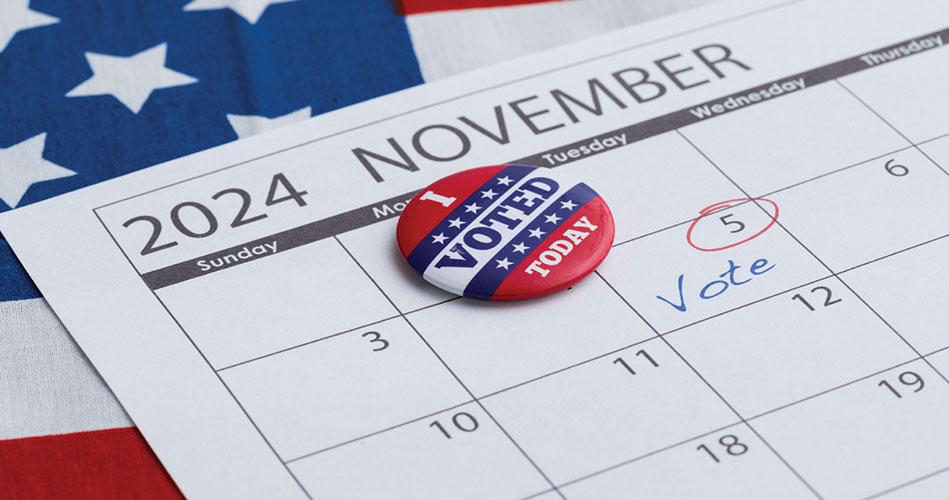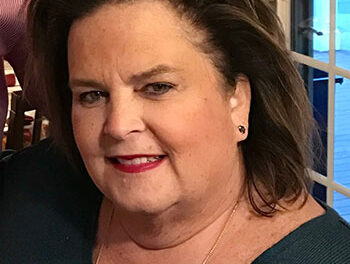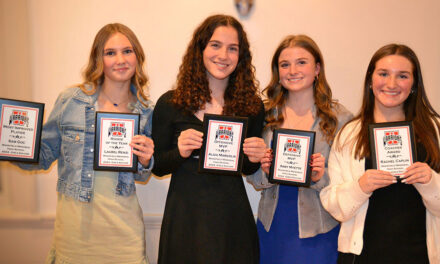By MAUREEN DOHERTY
NORTH READING — With the popularity of Early Voting options resulting in one-quarter of the state’s registered voters already casting their ballots in the 2024 Presidential Election as of press time, it might be easy to forget that next Tuesday, November 5 is Election Day — and the last day voters can cast their ballots.
Today, Thursday, October 31, the Early Voting polls at the Town Hall gymnasium, 235 North St., will remain open for a full 12 hours, from 8 a.m. to 8 p.m. Tomorrow, Friday, November 1, will be the last day to participate in Early Voting. The polls will be open during regular Town Hall hours, 8 a.m. to 1 p.m. in the gymnasium.
Voters who opted to receive ballots by mail may drop them off anytime during in-person Early Voting at the Town Clerk’s Office or in the 24-hour specially marked red, white and blue locked ballot box located outside Town Hall. At this point you may not want to risk mailing it back via U.S. Mail as it may not arrive at the Town Clerk’s office by Election Day.
If you miss the Early Voting dates or the deadline to request a mail-in ballot and will be unable to get to the polls on Tuesday, November 5, you have one more option, voting by traditional absentee ballot at the counter of the Town Clerk’s office. The deadline to apply for an absentee ballot and vote over the counter is noon on Monday, November 4.
ELECTION DAY VOTING
For those who prefer to vote in person on the traditional Election Day, Tuesday, November 5, the venue changes to the Parish Hall at St. Theresa Church, 63 Winter St., where all four of the town’s precincts have cast ballots for years. The Town Hall does not have the infrastructure and parking available to facilitate the volume of Election Day voting.
The polls are open for 13 hours on Election Day, from 7 a.m. to 8 p.m. (The mail-in ballot box outside Town Hall is also locked at 8 p.m. on Election Day to prevent late ballots from being deposited after the polls close.)
A specimen ballot is also viewable on the Town Clerk’s website (www.northreadingma.gov/town-clerk). The ballot has both front and back sides due to the number of candidates and the seven ballot questions (five statewide questions and two local questions).
Although we only hear about two candidates running for President — Kamala Harris and Donald J. Trump — there are actually six candidates for president on the ballot who hope to succeed Democratic President Joe Biden. They are: Democratic Vice President Kamala Harris, former Republican President Donald Trump, Green-Rainbow Party candidate Jill Stein, Libertarian Party nominee Chase Oliver, Socialism and Liberation nominee Claudia De La Cruz and Independent nominee Shiva Ayyadurai.
In the race for U.S. Senate, Democratic U.S. Sen. Elizabeth Warren is running against Republican challenger John Deaton.
Additional down-ballot races include the following:
• Incumbent Democratic Congressman Seth Moulton is running unopposed in the 6th District.
• A three-way race for Councillor in the Fifth District: Anne M. Manning-Martin (R), Eunice Delice Zeigler (D) and Jody A. Elliot (I).
• Incumbent state Senator Bruce E. Tarr (R), of Gloucester, the Senate Minority Leader, is running unopposed in the First Essex and Middlesex District.
• Incumbent state Representative Bradley H. Jones Jr. (R), of North Reading, the House Minority Leader, is running unopposed in the 20th Middlesex District.
• Incumbent Clerk of Courts Michael A. Sullivan (D) is running unopposed in Middlesex County.
• There is a two-way race for Register of Deeds, incumbent Maria A. Curatone (D) and challenger William “Billy” Tauro (I), both of Somerville.
• On the Regional School Committee for Northeast Metro Tech in Wakefield, there are 10 candidates for 12 available seats. Among them is North Reading’s incumbent Judith M. Dyment, who is running unopposed. Each of the 12 communities has one seat to fill but voters from each community vote for all of the candidates. The two communities without a candidate are Winthrop and Winchester. The other communities with one candidate each are Chelsea (Blanca Gacharna), Malden (James J. Holland), Melrose (Ward Hamilton), Reading (Robert S. McCarthy), Revere (Anthony L Caggiano), Saugus (Peter A. Rossetti Jr.), Stoneham (Lawrence M. Means), Wakefield (Brittany A. Carisella) and Woburn (Deborah A. Davis). With the exception of Chelsea’s Gacharna, all are candidates for re-election.
BALLOT QUESTIONS
An overview by Beacon Hill Roll Call of three statewide ballot questions — Q3 (Whether ride share drivers should be allowed to unionize), Q4 (Whether psychedelic substances in mushrooms and plants should be legalized for those 21+) and Q5 (Whether the hourly wage of tipped workers should be increased over the next five years until it matches the current state minimum wage by Jan. 1, 2029 at which point all tips could be pooled and distributed by management to all tipped and non-tipped workers) — is published inside today’s Transcript.
An overview by BHRC of the first two ballot questions was published in last week’s Transcript (Q1: Whether the State Auditor can audit the state legislature and Q2: Whether the MCAS should be eliminated as a graduation requirement).
North Reading voters also have two additional local ballot questions. The summary below on local Questions 6 and 7 comes from information provided by the town. The local questions will appear on the ballot as follows:
QUESTION 6
Shall the Town of North Reading be allowed to exempt from the provisions of proposition two and one-half, so-called, the amounts required to pay for the bond issued in order to reconstruct the Chestnut Street bridge over the Ipswich River?
QUESTION 7
Shall the Town of North Reading be allowed to exempt from the provisions of proposition two and one-half, so-called, the amounts required to pay for the bond issued in order to purchase a ladder truck for the Fire Department?
Summary of Q6 and Q7:
“Questions 6 and 7 propose temporary Proposition 2 ½ debt exclusions to reconstruct the Chestnut Street Bridge and to replace the Fire Department’s ladder truck. Prop. 2 ½ is a state law that caps the overall property tax ‘levy limit’ on existing property to 2 ½ percent increases per year, plus tax revenue from new growth that adds to the town’s tax base…The increase is for the amount of the annual debt service payments for approved projects, and it lasts only for the life of the related borrowing.
“As borrowing costs for previous debt exclusion projects wind down in FY26, the amount of property taxes attributable to debt exclusions will drop off by $0.15 per thousand dollars of valuation, or $121.65 for the average single-family home in town valued at $811,899.
“At October 2024 Town Meeting, North Reading voters approved two capital projects by two-thirds majority vote: a $4.5 million bridge on Chestnut Street, and a $1.9 million Fire Department ladder truck. The annual debt service is estimated at $307,688 for the bridge and $142,000 for the ladder truck. The combined project costs are $6.4 million, with an estimated $449,688 borrowing costs per year in the highest years.
“The Select Board sought authorization for borrowing regardless of the outcome of the debt exclusion vote so that these projects could proceed in a timely fashion. The outcome of the vote on Questions 6 and 7 will determine if the borrowing costs for these projects can be paid with property taxes beyond the Proposition 2 ½ limit.”
A yes vote would mean: If voters approve a Proposition 2 ½ debt exclusion on Ballot Question 6, the estimated annual household cost for the Chestnut Street Bridge would be $0.08 per thousand dollars of valuation in the highest borrowing cost years, or $65.96 per year for a single-family home valued at $811,899.
If voters approve a Proposition 2 ½ debt exclusion on Ballot Question 7, the estimated annual household cost for the Fire Department Ladder Truck would be $0.04 per thousand dollars of valuation in the highest borrowing cost years, or $31.04 per year for a single-family home valued at $811,899.
Each project is considered separately on its own Ballot Question, but if both were approved, the estimated annual household cost of the combined debt exclusions would be $0.12 per thousand dollars of valuation in the highest years, or $97 per year for a single-family home valued at $811,899.
A no vote would mean: Town Meeting approved seeking authorizations for borrowing regardless of the result of debt exclusion votes. If debt exclusions fail on election ballot Questions 6 or 7, the debt from these projects would need to be absorbed into the existing tax levy. The projects could also be funded via another source at a future Town Meeting or a future debt exclusion vote.
There is a calculator to estimate how this would impact your property tax bill based on your home’s assessed value, if it’s above or below the average value of $811,899. Visit “Property Tax Impact Calculator” on the MA Dept of Revenue, Division of Local Services online: https://dlsgateway.dor.state.ma.us/reports/rdPage.aspx?rdReport=Analysis.TaxImpactCalc. The annual adjustment / borrowing costs for both projects combined is estimated to be $449,688 per year.
The Massachusetts Division of Local Services offers short video clips explaining Proposition 2 ½ at https://www.mass.gov/info-details/proposition-2-12-and-tax-rate-process.





